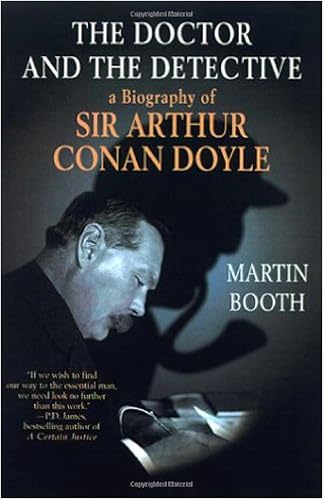Sir Arthur Conan Doyle (22 May 1859 – 7 July 1930) – Scottish writer, physician and spiritualist – best known for his Sherlock Holmes stories.

After his father’s death, the burden of supporting a large family fell on Arthur Conan Doyle. To supplement his income he began writing short stories. His first story of note was A Study in Scarlet published in the Beeton’s Christmas Annual 1887 (featuring the first appearance of Sherlock Holmes. This later led to a contract writing more Sherlock Holmes stories for the Strand magazine. It was in these early stories that he developed the character of Sherlock Holmes. It was a character that fascinated the reading public and he soon became one of the best-loved fictional characters. Sherlock Holmes always had an element of mystery – the sharpest mind and his unbelievable powers of observation.
“…when you have eliminated the impossible, whatever remains, however improbable, must be the truth…”
-Sir Arthur Conan Doyle, (Sherlock Holmes)
Sherlock Holmes also had his share of human weaknesses such as smoking and drug addiction. His partner, the sensible, loyal Watson proved the ideal counterbalance to the highly strung genius of Holmes.
The success of Sherlock Holmes enabled Conan Doyle to retire from his medical profession and become a full-time writer. But, it was not the popular Sherlock Holmes stories which inspired him the most. He was more interested in writing serious historical novels and becoming known as a famous writer in this genre. However, his historical novels never brought him the same financial remuneration or fame as his Sherlock Holmes stories did.
After a while, Doyle became increasingly frustrated with the public’s obsession with Holmes, at a time when he was growing weary of the stories. Therefore, he decided to retire Holmes in 1893 by having him plunge into a ravine with his arch-enemy Professor Moriarty. Holmes hoped this would give him more time to write his ‘serious novels’ – but, much to his frustration, he struggled to escape the public’s perception of him as the creator of Holmes. In fact, it wasn’t uncommon for members of the public to equate Conan Doyle with Sherlock Holmes – much to his annoyance.
In 1900, Conan Doyle served in a field hospital in the Boer war. He also later published a pamphlet The War in South Africa: Its Cause and Conduct, which sought to justify British actions in the unpopular Boer war. For his services in the war, he was knighted, though undoubtedly his fame as the creator of Sherlock Holmes was also a factor.
In, 1906, his first wife, Louisa Hawkins, died after a long battle with Tuberculosis. It was a big blow to Conan Doyle who had moved to Switzerland to help her health.
After getting married to his second wife, Denise Steward a year later, he again was in the need for more money to finance a lavish new family home. Again, Doyle turned to his ever-profitable Holmes, securing a great deal with an American publisher for more Holmes stories. Thus, Holmes was resurrected, Conan Doyle cleverly wrote that Holmes had never died in the fall but cunningly escaped Moriarty and had gone into hiding from his enemies.
Conan Doyle’s most famous character was a man of great reason and science, so it was perhaps ironical that Conan Doyle was to become greatly interested in the new religion of spiritualism. A large part of spiritualism was the contacting of deceased relatives through seances. For many years, Conan Doyle had toyed with the ideas, but the traumatic years of the First World War (where he lost a brother and son) changed his outlook to that of a fervent believer. Conan Doyle became one of the chief proponents and public faces for spiritualism. Conan Doyle felt that this proof of life beyond death could give fresh impetus to religion.
“Religions are mostly petrified and decayed, overgrown with forms and choked with mysteries. We can prove that there is no need for this. All that is essential is both very simple and very sure.” (The New Revelation 1918)
The success of Conan Doyle’s Holmes enabled him to pursue many different interests. As well, as researching spiritualism, Conan Doyle found time to fight miscarriages of justice such as the George Edalji case.
“I should dearly love that the world should be ever so little better for my presence. Even on this small stage, we have our two sides, and something might be done by throwing all one’s weight on the scale of breadth, tolerance, charity, temperance, peace, and kindliness to man and beast. We can’t all strike very big blows, and even the little ones count for something.”
Arthur Conan Doyle, Stark Munro Letters (1894)
Citation: Pettinger, Tejvan. “Biography of Sir Arthur Conan Doyle”, Oxford, UK. biographyonline.net. Published 25th June 2009. Last updated 15 February 2018.
The Doctor and the Detective: A Biography of Sir Arthur Conan Doyle
The Doctor and the Detective: A Biography of Sir Arthur Conan Doyle at Amazon
The Complete Sherlock Holmes
The Complete Sherlock Holmes at Amazon
Related pages
Writers and authors – Famous authors such as J.R.R. Tolkien, William Shakespeare, J.K. Rowling, Jane Austen, Leo Tolstoy, John Steinbeck and Ernest Hemingway.
– Famous authors such as J.R.R. Tolkien, William Shakespeare, J.K. Rowling, Jane Austen, Leo Tolstoy, John Steinbeck and Ernest Hemingway.




